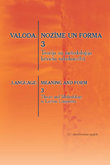Prievārdu pētīšanas metodes
Methodology for describing prepositions
Author(s): Eglė Žilinskaitė-ŠinkūnienėSubject(s): Language and Literature Studies, Theoretical Linguistics, Psycholinguistics, Baltic Languages
Published by: Latvijas Universitātes Akadēmiskais apgāds
Keywords: prievārds; komponentu analīze; kognitīvā lingvistika; prototips; ideālā nozīme; leksiskie tīkli; attēlu shēma; radiālā kategorija;
Summary/Abstract: The article presents various approaches to semantic analysis of prepositions. It starts with the descriptive and structural methods (e.g., Grabis 1959; Lindkvist 1972, 1976; Nītiņa 1978, 2007; Valiulytė 1976, 1997a, 1997b, 1998), taking into account componential analysis (Bennett 1975; Kilius 1977, 1980) and logical approach to prepositional semantics (Cooper 1968). The abovementioned works are mostly concerned with defining the semantic invariant or presenting the lists of the uses of the preposition without any additional information about the relations among the senses.Prepositional semantics received a fair amount of attention from the beginning of cognitive sciences in the early eighties of the 20th century. Rosch’s principles of categorization (Rosch 1978) and prototype theory led to understanding of the preposition as a natural category with the prototypical (or ideal) member, fuzzy boundaries and well interrelated senses (or use types, e.g., Herskovits 1986), which were represented as image-schemas or lexical networks (Lakoff 1987; Lindner 1983; Bellavia 1996; Dewell 1994, 1996; Meex 2001; Tyler, Evans 2003). Another approach to prepositional semantics was proposed by Steven C. Levinson and the Language and Cognition group at Max Planck institute for Psycholinguistics (Levinson 1992, 2003; Levinson et al. 2003, 2006). It is an onomasiologically based method to investigate spatial description and conception, in which the locational situations are described according to either topological or angular (i.e., intrinsic, relative or absolute frames of reference) information, while the dynamic contexts – according to Talmyan typology of the verb-framed and satellite-framed languages (Talmy 2000).
Journal: Valoda: nozīme un forma
- Issue Year: 2013
- Issue No: 3
- Page Range: 159-171
- Page Count: 13
- Language: Latvian

